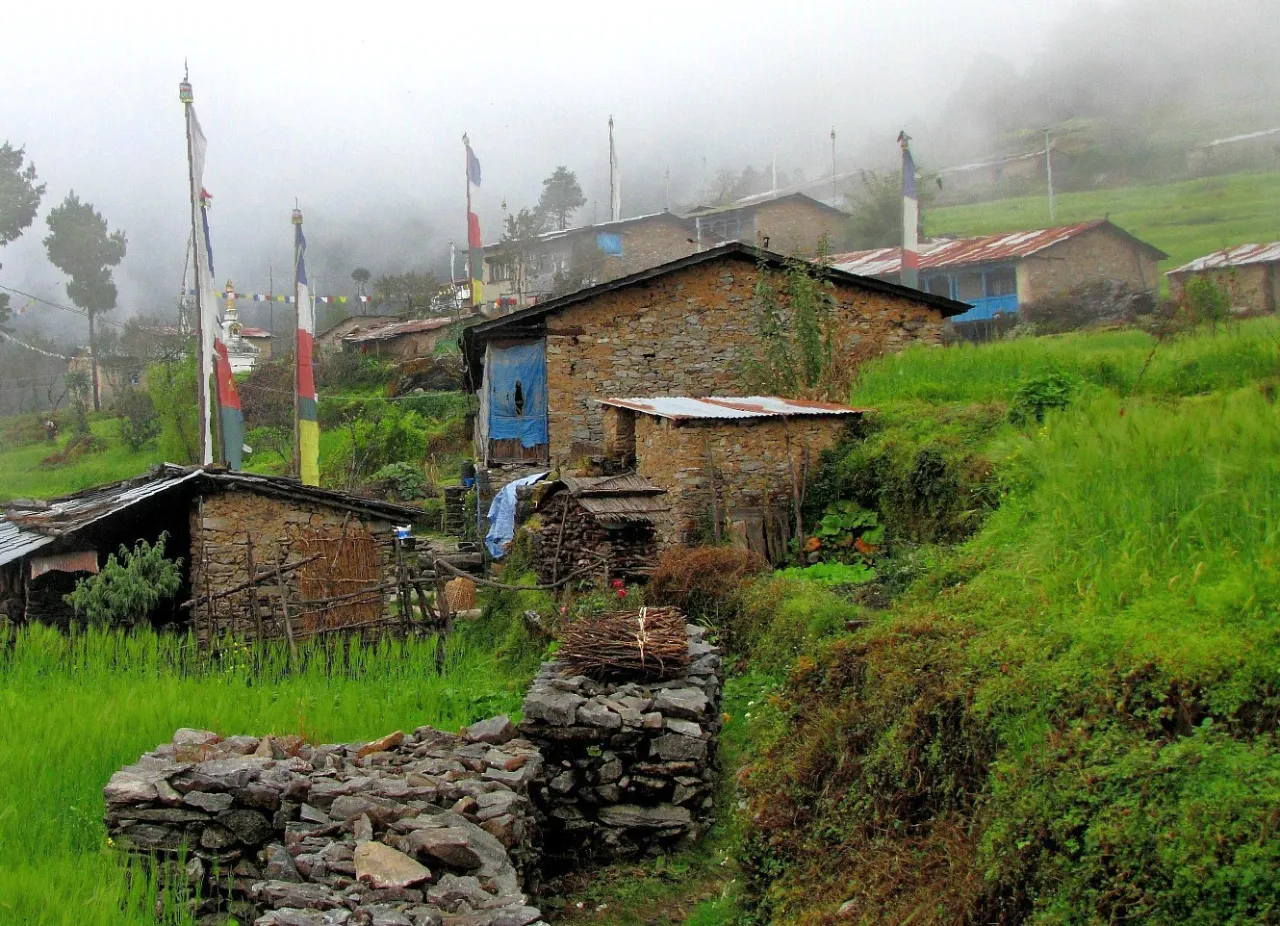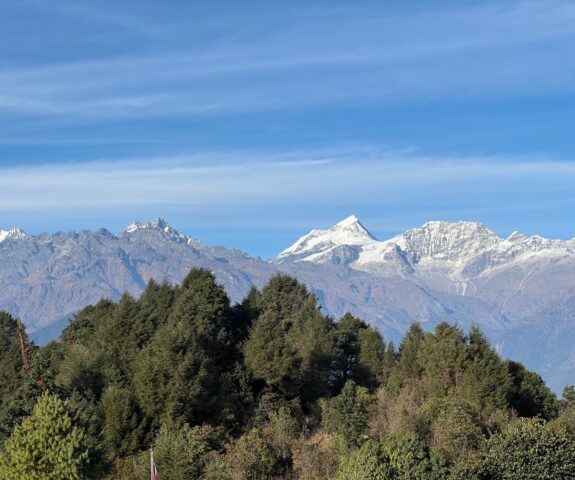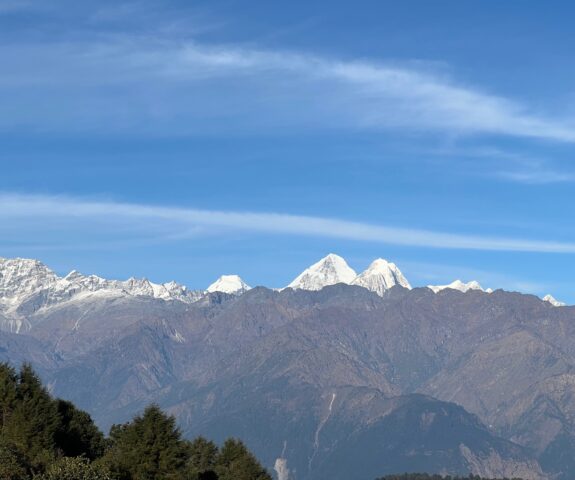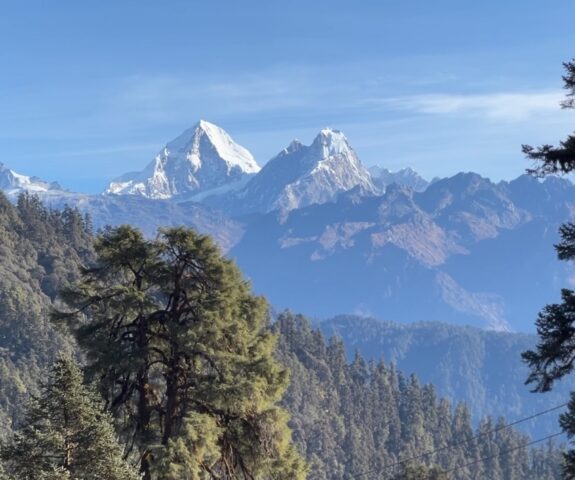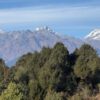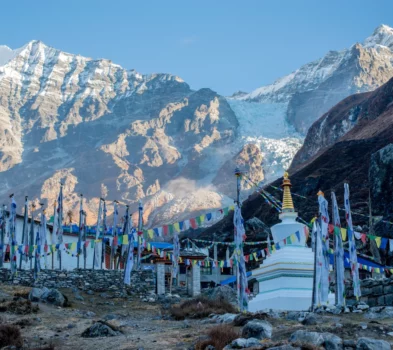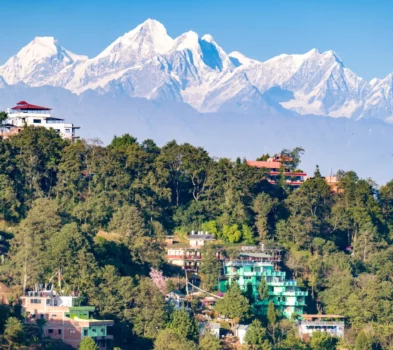Duration
9 DaysHelambu Trek
Trip Grade
ModerateGroup Size
1-16 PeopleMax Altitude
2,610m. / 8,563ft.Best Season
Mar-May/ Aug- NovActivity
Trekking & HikingMeals
Breakfast, Lunch & DinnerAccommodation
Hotels & TeahousesTransportation
Private Vehicle & BusTrip Customization
On request (click here)Highlights of Helambu Trek
- Short and near Kathmandu
- Breathtaking views of stunning mountains, including Langtang, Dorje Lakpa, and Ganesh Himal
- Rich Buddhist tradition, culture, and heritage
- Witness traditional and scenic villages like Tarkeghyang and Sermathang
- Walk through dense pine and rhododendron forest
- Peaceful trails, fewer crowded, and no traffic
- Explore the oldest Buddhist monasteries and sacred chortens
- Moderate altitude – no risk of altitude sickness and perfect for beginners
- Witness numerous flora and fauna
- Warm Hospitality of locals
- Unique architecture of Mountain communities
Trip Introduction
Helambu trek is one of the most culturally rich and scenic destinations of Nepal, lying just north of Kathmandu. Helambu offers a harmonious blend of natural beauty, easy accessibility, and cultural heritage. Helambu is a hidden gem that favors more popular trekking routes like Annapurna and Everest and also promises a peaceful yet enriching experience for nature enthusiasts, spiritual seekers, adventure thrill seekers, and photographers.
Helambu trek offers trekkers a chance to immerse themselves in the authentic traditions of the Hyolmo people without drifting afar from Kathmandu. This is a perfect short trek to escape into the Himalayas, which offers a unique combination of dramatic crystal line, snowcapped mountain peaks, lush forests, and preserved Buddhist culture in just a week.
Helambu region derives its name from the Hyolmo, also sometimes spelled Yolmo or Helmu by ethnic groups and indigenous people of this area. The name Helambu itself is believed to have originated from the words Hyolmo and Ambu, which refer to potatoes in the local dialect. The locals’ lifestyle, tradition, and culture are deeply rooted in Tibetan Buddhism.
While trekking in this region, you will get a chance to witness various ancient monasteries, Mani walls, prayer flags fluttering in the wind, and Chortens adorning every village. Trekking in Helambu feels like a journey in a living heritage that retains the country’s old architecture and customs.
The Helambu trek typically starts from Sundari Jal lies in Shivapuri National Park or Melamchi Bazaar, just an hour’s drive from Kathmandu. From there, trekkers ascend gradually through pristine forests, cascading waterfalls. The trek goes winding through the mountain trails that connect appealing and picturesque villages like Chisapani, Kutumsang, Thadepati, Tarkeghyang, and Sermathang.
This Helambu trek rarely exceeds the highest elevation of 3,600 meters, which is ideal for beginners, families, elderly hikers, and those looking to enjoy a Himalayan trekking experience without risking altitude sickness.
This Helambu trek offers breathtaking views of various snowcapped mountain peaks, including Ganesh Himal, Dorje Lakpa, and Langtang ranges. These mountains offer a sublime backdrop to the terraced farms and green hills, and don’t dominate the skyline the way Everest does in the Khumbu region. Rhododendron (National Flower of Nepal) blooms in a variety of colors in spring, while autumn presents clear skies and golden-hued forests.
The peaceful ambiance blends with the occasional chant of mantras of monks and the soft rustle of prayer flags, creating a spiritually uplifting terrain which is perfect for those seeking healing and inner peace.
The greatest asset of the Helambu trek is its cultural depth. The trail to Helambu winds through various Buddhist Monasteries, which date back hundreds of years. Witnessing the holy place in Helambu sacred spaces offers trekkers a chance to learn about old Buddhist rituals, and the stories from Monks feel like you’re directly connecting with Buddha.
On the way to Helambu, you’ll be trekking via various beautiful villages like Tarkeghyang and Sermathang, which are famous for their warm hospitality and monasteries. Local lodges and home stays are common where trekkers get the opportunity to taste local, authentic Hyolmo and Tamang cuisines like Yak cheese, Tibetan butter tea, and buckwheat bread. The lifestyle of the locals of this region is untouched by modernism, with very kind hearts and a welcoming nature, which adds authenticity to the experience.
The best part of the Helambu trek is its richness in ecology, which adds highlights to the trek. The trail passes through Nagarjun, Shivapuri, and Langtang National Park, home to a wide biodiversity of flora and fauna.
On the way, trekkers will enjoy bird watching, as the forest is alive with the calls of Cuckoos, Himalayan monals, and many other native birds, which is perfect for nature enthusiasts. If luck allows, trekkers can encounter wildlife such as wild boars, musk deer, and black bears. This region preserves numerous medical herbs growing in the wild, so this is the hotspot for botanical research.
The Helambu trek is budget-friendly in comparison to other Himalayan adventures, which is easily accessible and can be comfortably completed in 5 to 9 days, depending on the starting and ending point. Tourism is the main source of income of this region, and locally owned tea houses or lodges are available easily, so trekking and staying in this place can indirectly help locals as well as preserve the culture of the region.
Additionally, the trek offers an opportunity to interact with various ethnic groups such as Tamang, Limbu, and Sherpas, especially in the lower areas of the region. The diversity of these communities is reflected in the architecture, stone houses with intricately carved wooden windows, and the religious structures that combine both Hindu shrines and Buddhist stupas. The blending of traditional lifestyle and faiths makes Helambu not just a geographical region but a living mosaic of Nepal’s culture and spiritual landscape.
The Helambu trek is just not about witnessing stunning mountains and monasteries, but it is about connecting with the region that weathered adversity with strength and grace. The Calm energy of the Helambu is a soul-soothing experience that connects you with nature, culture, and yourself.
Outline Itinerary of Helambu Trek
Day 01: Arrival in Tribhuvan International Airport, Kathmandu (1,400m)
Day 02: Kathmandu Sightseeing
Day 03: Drive to Sundarijal from Kathmandu and trek to Chisapani (2,165m)
Day 04: Trek to Kutumsang from Chisapani (2,470m)
Day 05: Trek to Thadepati from Kutumsang (3,650m)
Day 06: Trek to Tarkeghyang from Thadepati (2,560m)
Day 07: Trek from Tarkeghyang to Sermathang (2,610m) via Aama Yangri Peak (3,771m)
Day 08: Trek from Sermathang to Melamchi Bazaar (870m) & Drive to Kathmandu (1,400m)
Day 09: Departure
Our guests sharing their experiences (Photo/Video Gallery)
Detail itinerary of Helambu Trek
Day 01: Arrival in Tribhuvan International Airport, Kathmandu (1,400m)
Upon your arrival at Tribhuvan International Airport, our airport representative will be waiting for you to greet you and escort you to your hotel.
After check in to your hotel, the rest of the day will be yours, you can relax in your hotel’s ambiance, or you can explore nearby places from your hotel.
In the evening, we will host a welcome dinner for you, which includes authentic Nepali cuisine where you can enjoy typical Nepali food, Cultural dance, and songs.
In the same evening, you’ll meet your guide and he/she will brief you about the trek, and you can ask any doubts and last minute questions about the Helambu trek.
Overnight stay at a hotel in Kathmandu.
Meal: Welcome Dinner
Accommodation: 3 star hotel
Day 02: Kathmandu Sightseeing
Today, after breakfast in your hotel. Our guide and driver will take you to the Historical places like Pashupatinath, Swayambhunath, Boudhanath, and Kathmandu Durbar Square, which are listed as UNESCO World Heritage Sites, before heading for the Helambu trek.
Pashupatinath, Nepal: Temple of Lord Shiva (god of gods and goddesses). Pashupatinath temple is Nepal’s most sacred Hindu temple, where you can witness marriage, celebrate festivals, as well as cremation ceremonies on the banks of the Bagmati River beside Pashupatinath.
Boudhanath Stupa: A massive mandala serves as the heart of Tibetan Buddhism and the largest spherical stupa in Nepal, surrounded by colorful gompas and symbolic prayer flags.
Swyambhunath Stupa: Also known as Monkey Temple, a spiritual site perched on a hilltop that offers a stunning view of the Kathmandu valley.
Kathmandu Durbar Square: The most visited place by tourists, which holds historic value and culture. This place used to be the palace of the Kathmandu king centuries ago. This palace is also a showcase of Newari Architecture, ancient temples, and the living Goddess called Kumari.
After the sightseeing tour, you can do last-minute shopping for your trek in Thamel. You’ll meet your guide at your hotel in the evening for a briefing and gear check for your trek. Overnight stay at a hotel in Kathmandu
Meal: Breakfast
Accommodation: 3 star hotel
Day 03: Drive to Sundarijal from Kathmandu and trek to Chisapani (2,165m)
Today, after breakfast in your hotel, our guide and driver will be waiting for you in your hotel lobby. You’ll drive to Sundarijal. After an hour of driving, you’ll reach Sundarijal, the gateway to Shivapuri National Park.
You’ll begin your trek by ascending stone steps alongside a waterfall in Sundarijal and continue walking through a dense forest of Oak and Rhododendron. Your trail will pass via some of the beautiful villages of Mulkharka and ascend to the ridge-top village of Chisapani.
After reaching Chisapani, you’ll be amazed by the first panoramic view of various Himalayan ranges, including Ganesh Himal, Annapurna, Langtang, and, if lucky, Everest can be viewed.
Overnight stay at the Tea House.
Activity: 1 hr drive & 5-6 hrs trek
Max. Altitude: 2,165m/7,103ft.
Meal: B L D
Accommodation: Teahouse
Day 04: Trek to Kutumsang from Chisapani (2,470m)
Today you’ll be trekking to Kutumsang from Chisapani. The trail takes you through a mix of hilly landscapes and various beautiful villages.
The trek descends through dense forest and terraced farmland to Pati Bhanjyang, then you’ll gradually ascend to the hilltop village of Gul Bhanjyang.
After taking lunch in Gul Bhanjyang, your trail takes you to the village of Kutumsang, which offers stunning views of the northern Himalayan ranges. Overnight stay at the Tea House.
Activity: 6-7 hrs trek
Max. Altitude: 2,470m/8,104ft.
Meal: B L D
Accommodation: Teahouse
Day 05: Trek to Thadepati from Kutumsang (3,650m)
Today you’ll leave Kutumsang and head to Thadepati. Today’s trail enters the isolated region with very few human settlements. You’ll climb to Thadepati via lush rhododendron and fir forests.
As you ascend to Thadepati, the altitude rises, the dense forests become thin, and the trail opens to a wide range.
Thadepati is the highest point of your trek to Helambu, and this place offers a breathtaking view of Snow-capped peaks, including Dorje Lakpa, Langtang, and Gauri Shankar. Overnight Stay at Tea House.
As the altitude increases, the forest thins and the trail opens to wide ridges offering spectacular views of Langtang Lirung, Dorje Lakpa, and even distant Gauri Shankar on clear days. Thadepati, situated on a ridgeline, is the highest point of the trek.
Activity: 5-6 hrs trek
Max. Altitude: 3,650m/11,975ft.
Meal: B L D
Accommodation: Teahouse
Day 06: Trek to Tarkeghyang from Thadepati (2,560m)
Today, trek is a rewarding voyage as you descend to Helambu valley, a culturally rich village from Thadepati. Today you’ll be going to the lush zone from the alpine zone of the Helambu trek.
The trail begins with a steady descent through enchanting rhododendron and pine forest. While trailing to Tarkeghyang, you will pass through a small yak pasture and cross several streams and a suspension bridge while enjoying the views of snowcapped peaks in your vicinity.
As you descend, you will gradually enter to Yolmo region, home to a distant Buddhist locality, and the scenery becomes greener and more inhabited.
After reaching Tarkeghyang, you’ll witness beautiful stone houses, terraced farmlands, and a 300-year-old Monastery, which is itself a highlight of the Helambu trek. Overnight stay at the Tea House
Activity: 5-6 hrs trek
Max. Altitude: 2,560m/8,399ft.
Meal: B L D
Accommodation: Teahouse
Day 07: Trek from Tarkeghyang to Sermathang (2,610m) via Aama Yangri Peak (3,771m)
This day is a special and spiritually rich day in your Helambu trek. Today you’ll hike about 1 hour to Aama Yangri Peak. It is one of the highest and most revered viewpoints in the Helambu trek, which offers 360-degree views of snowcapped mountain peaks including Langtang Lirung, Dorje Lakpa, Ganesh Himal, Gaurishankar many others.
After spending some good time in Aama Yangri, you’ll descend back to Tarkeghyang. You will have a good lunch in Tarkeghyang and again start walking to Sermathang culturally rich Yolmo village. The trail Sermathang is gentle and easy.
You’ll walk through dense forest, cross small streams, and visit traditional villages with classic stone houses and terraced fields. Overnight stay in the Tea House.
Activity: 7-8 hrs trek
Max. Altitude: 3,771m/12,372ft.
Meal: B L D
Accommodation: Teahouse
Day 08: Trek from Sermathang to Melamchi Bazaar (870m) & Drive to Kathmandu (1,400m)
After breakfast in the peaceful village of Sermathang, begin your final day on the trail with a gentle upward journey.
The trail meanders through fascinating Tamang and Yolmo townlets like Nigale, Gyalsha, and Raithani Gyang, offering one last chance to witness the pastoral life of the Helambu region.
The route descends steadily through forested crests, terraced fields, and spreads. Along the way, you will pass traditional houses, cloisters, and chortens — a memorial of the area’s deep spiritual and artistic roots.
As you descend, the temperature becomes warmer and further sticky, and the geography transitions from alpine to tropical.
After about 3 – 4 hours of touring, you’ll reach Melamchi Bazaar – a small, Bustling city located along the Melamchi River. It marks the end of your journey got the Helambu trek. Then, your vehicle will be staying for the drive back to Kathmandu.
The drive takes around 4 – 5 hours, following scenic, winding roads through lush, dense forests and across the Melamchi River, before joining the Arniko Highway back to the capital. Upon appearance in Kathmandu, check into your hotel and enjoy some well- justified rest.
In the evening, a farewell regale will be arranged to celebrate your successful Helambu trek.
Activity: 3-4 hrs trek & 4-5 hrs drive
Meal: B L D
Accommodation: 3 star hotel
Day 09: Departure
Today is your last day in Nepal, for the journey of the Helambu trek. After breakfast in your hotel in Kathmandu, our airport representative and driver will escort you to Tribhuvan International Airport (TIA).
If you would like to extend your stay in Nepal, you can tell us without hesitation; we can arrange it easily.
Wishing to serve you again in your next upcoming journeys in Nepal during your vacation, till then, a very good bye from Nepal. Have a safe and Happy Journey!
Note:
If you have your own private group and want to make your trip private, we can run the custom trip all the day as per your requirements and group size.
Includes and Excludes
What are included with package?
- Pick up from Airport and Transfer to the hotel: Upon your arrival in Kathmandu, you’ll be greeted by a representative who will transfer you to your hotel for check-in.
- Three Night’s 3-star hotel in Kathmandu with Breakfast: Enjoy three nights of accommodation in a 3-star hotel in Kathmandu, including daily breakfast to start your day.
- Lunch, Dinner, and Breakfast during trekking: The package includes standard meals (lunch, dinner, and breakfast) during your trek, providing you with the necessary nutrition for each day.
- Trekking Permit: The trekking permit required for the specific trail you’ll be following is included. This allows you to trek in protected regions like the Annapurna Conservation Area.
- Trekkers’ Information Management System (TIMS) Permit: The TIMS permit is essential for trekkers to register their details with the government to ensure safety. This will be provided to you.
- Kathmandu Sightseeing by private vehicle with an experienced tour guide: A private vehicle will take you on a guided sightseeing tour of Kathmandu’s famous attractions, with an expert guide providing insights into each place.
- Kathmandu to Sundarijal by private vehicle: Transportation from Kathmandu to Sundarijal, the starting point of your trek, will be arranged in a private vehicle for comfort and convenience.
- Melamchi Pul Bazaar to Kathmandu by bus: After completing your trek, transportation will be arranged to bring you back from Melamchi Pul Bazaar to Kathmandu by bus.
- All necessary paper works: All required documentation for the trek, including permits, permissions, and registration, will be handled and provided.
- All accommodations in lodges/tea houses during the treks: Your accommodation during the trek will be in lodges or tea houses along the trekking route, offering basic but comfortable facilities.
- An experienced, helpful, and friendly Guide, porters (1 porter for 2 clients): An experienced guide will lead you through the trek, and a porter will be assigned (1 porter for 2 clients) to carry your gear, ensuring your comfort.
- An arrangement of Travel rescue: In case of emergencies, arrangements for rescue operations will be made, ensuring your safety during the trek.
- Medical supplies (first aid kit will be available): A first aid kit will be available for use in case of minor injuries or medical concerns during the trek.
- All government taxes: All taxes related to the trekking permits and other related services are included in the package cost.
- Last night’s farewell dinner at an authentic Nepalese restaurant with a cultural performance: On the final evening of your trip, enjoy a farewell dinner at a traditional Nepalese restaurant while watching a cultural performance, offering a memorable end to your journey.
What are not included with package?
- Nepal Visa Fee: The cost of obtaining a Nepal visa is not included, but you can easily get a tourist visa upon arrival at the Kathmandu airport. The visa fee varies depending on the duration of your stay.
- Entrance Fees in Kathmandu: Any entrance fees for monuments or sightseeing sites in Kathmandu, such as temples, palaces, and museums, are not included in the package cost.
- International Airfare to and from Kathmandu: The cost of flights to and from Nepal is not included. You will need to book your own international flights.
- Extra Night Hotel Accommodation in Kathmandu and Mountain: If you arrive early, depart late, or return from the mountains earlier than planned due to weather or any other reason, any additional nights spent in Kathmandu or on the trek are not included and will be at your own expense.
- Travel and Rescue Insurance: It’s highly recommended to have travel and rescue insurance. This type of insurance will cover you in the event of an emergency, illness, or accident during the trek. The cost is not included in the package.
- Personal Expenses: Any personal expenses during the trek, including phone calls, laundry, bar bills, battery recharges, extra porters, bottled or boiled water, showers, or any other incidental expenses, are not included in the package. These will need to be paid by you directly during the trip.
Pick Your Suitable Date
Book a Private Trip
Private & Group Discount Price
-
1 -
1 person
US$ 1200
-
2 -
2 people
US$ 800
-
3 -
5 people
US$ 750
-
6 -
10 people
US$ 700
-
11 + people
9999
US$ 600
Total Cost:
US$ 1200
Route Map & Altitude Chart
Kathmandu
Start/End point
Kathmandu
Trip Information
Best Time to Do the Helambu Trek
The great time to trek to Helambu trek is the spring season (April to early June) and the Autumn Season (September to early November). In these seasons weather remains quite stable, with clear skies and great visibility, offering clear views of landscapes and the snowcapped Himalayan range. Trails remain dry and more approachable, which makes the trek secure.
Spring offers the flowering as well blossoming landscapes along with the vibrant environment, while autumn offers cultural big festivals with traditional and cultural practices in the whole country, and the weather brings the crystal-clear views of majestic mountains. In this season, you feel different vibes in the air.
The summer season (June to August) is also possible for trek, but slippery trails, leeches, frequent rain, and cloud cover hide mountain views.
Winter Season (late November to March) is very cold at high altitudes (especially Thadepati), snow can block paths, so it’s better to avoid unless you are an experienced trekker.
Quick Overview
- Best time: April-June, September–November
- Possible: June – August
- Not recommended: Late November- March (chances of snow and cold)
Accommodation, Food, and drink while Helambu trek
The Helambu Trek is a relatively easy and accessible trek near Kathmandu, and it’s a great option for those looking for a short and culturally rich experience.
Along the trail, you’ll find basic accommodation in local teahouses. These are small lodges run by local families that offer simple rooms, which usually come with two single beds, blankets, and shared bathrooms. Heating is limited—most places only have a stove in the dining area—so it can get quite cold at night, especially in higher villages like Tharepati.
When it comes to food and drinks, expect a basic but filling menu. Most teahouses serve the typical Nepali trekking food: dal bhat (rice with lentils and vegetables), noodle soup, pasta, potatoes, and sometimes Tibetan bread or pancakes.
During the Helambu Trek, the food is usually vegetarian, as meat isn’t always available or fresh in remote areas. For hot serves, you will find tea, coffee, and usually hot lemon, as well as bottled or boiled water. It’s a good idea to bring your own water purification tablets or a filter to save money and reduce plastic waste.
Overall, the Helambu Trek offers a simple and quiet trekking experience. Don’t expect luxury, but the teahouses are comfortable enough, and the food will keep you energized. Plus, the local people are warm and welcoming, which adds a lot to the experience.
Preparation and Fitness
These 9 days Helambu trek is considered moderate in difficulty and doesn’t reach very high altitudes (max. 3,750m if including Aama Yangri). Good physical preparation and smart planning are essential for an enjoyable and safe experience.
Fitness Requirements:
- You don’t need to be that athletic person, but good health is preferable.
- If you truly want to do the Helambu trek, we recommend that you have some of the basic training like hiking, stair climbing, aerobic workouts, as well as cycling and jogging for about 30–45 minutes, 3–4 times/week.
- Practice some basic exercises carrying a light backpack, which will help you to simulate trek conditions.
Mental Preparation:
- You need to make up your mind that you will be having the basic services over luxury, like accommodation in a basic (shared toilets, limited hot water)
- Changes in weather and trail conditions
- Limited internet/mobile coverage
Packing Tips:
- You must not forget to bring quality trekking gear, which you think you will going to need to carry firstly first aid kit and other basic essentials such as down jackets, sleeping bag, warm layers, and trekking boots.
- Recommended to carry light snacks, power banks, water bottles, towels, and other essentials as needed etc.
- Sandals or slippers for the teahouse use
Altitude Awareness:
- Although the Helambu Trek stays below major high-altitude danger zones, altitude can still affect you above 3,000m (especially at Thadepati and Aama Yangri).
- Keep yourself hydrated and ascend carefully.
- Avoid alcohol and smoking during the trek
- Rest properly and eat balanced meals
- Carry a first aid box including Diamox.
Important Notes
- No technical climbing skills are required for the Helambu trek
- Suitable for beginners with moderate fitness
- Hiring a local guide or porter is highly recommended for route support, safety, and cultural insights
Permits & Paperwork
The trekking area in which the trail is drawn for the Helambu trek falls under the region of Langtang National Park, and you need the proper permit to get access or to get inside the trekking region. So, you’ll need:
TIMS Card (Trekkers’ Information Management System)
Langtang National Park Entry Permit
Our trekking agency can handle these, or you can get them in Kathmandu. And above permits should be filled with the proper legal information of trekkers and should be done with the proper procedure.
Essential Packing Gear List for Helambu Trek
If you have decided to go on the Tamang Cultural trek, Helambu Trek in Nepal, we assure you that you will have a fantastic time ahead. But what should you pack for your Adventure? What will be the right gear to make your trip more fabulous? To help you with this, we have compiled a packing list of essential items that you mustn’t forget to bring along.
- Passport ( min 6 months valid)
- Cash, credit card
- List of important addresses and contact details
- 2-3 passport photos (optional)
- Copies of all important travel documents (passport, visa, airline ticket, insurance policy, etc.)
- A sturdy 70 L trekking backpack which will be carried by your porter (please note that our assigned 1 porter will carry 2 clients’ luggage up to 20-25 kg.
Note: We will provide each participant with a spacious 70 to 75 L Company logo duffle bag to conveniently carry your trekking gear, which you have to return once the trek is complete. - A 30 L Daypack that has room for your essentials such as camera, mobile, Passport, important documents, water bottle, day-useable medicine, chocolate bars, raincoat, etc., which will be carried by you.
- Protective cover for a backpack or travel bag.
- Hiking Boots: Preferably ankle-high boots to prevent ankle sprain
- Regular Shoes: For small strolls and exploration around the city
- Second, a light pair of shoes and possibly sandals
- Micro Spikes or Ice Cleats for the winter trekking over snow and ice
- Gaiter for added protection in snow
- A rain and wind-resistant, lightweight down jacket for warmth, with a good helmet hood
- Summer-light, as well as winter warm clothing
- Quick-drying shirts made of synthetic fabrics
- Warm and cool vests or T-shirts
- Functional synthetic underwear
- Sports Bra for Female Trekker
- A waterproof pair of trousers
- Regular trousers of quick-drying fabric
- Hiking shorts
- Cargo Pants with multiple pockets to hold your small items, such as knives or chocolates
- Woolen or fleece pants
- Trekking socks, both thick and woolen fabric, and lighter wool socks
- Wool hat, gloves, and scarf
- A light cotton scarf or a bandanna for protection of your head, neck, ears, and mouth
- Sun hat, and sunglasses with 100% UV protection (for trekking trips, even with stray light and nose protection)
- Sunscreen cream or lotion with a high sun protection factor (at least 15, for trekking trip,s even at least 30)
- Sunscreen lipstick with a high SPF (at least 20, for trekking trips, even at least 30 or sunblock)
- Mosquito repellent (Optional)
- Comfortable light night clothes and shoes
- A drinking bottle that can be used as a hot water bottle on frosty nights
- Flip-flops or bathing shoes for using the showers
- Water purifiers: if you need to refill water from the tap or stream en route
- Headlamp: for a midnight or pre-dawn trip towards the viewpoint
- Quick-drying towel and sample-size toiletries for washing your feet and face
- Your Personal first-aid kit: with basic medical supplies such as bandages for sprains, antidiarrheal and antibiotics, iodine wipes for scrapes and cuts, plasters, aspirin, or ibuprofen, moleskine for preventing blisters, Diamox (acclimatizing medicine), and your Personal medication
- Sleeping bag appropriate for all-season treks (we can hire in Kathmandu)
- Waterproof money belt, chest bag, leg bag, or belt bag for storing important travel documents or valuables
- Toothpaste, Toothbrush, and soap
- Deodorants
- Moisturizer
- Nail clippers
- Feminine hygiene products (Sanitary Pads)
- Small mirror
- Wet wipes
- Hand sanitizer
- Comb
- Camera with sufficient memory cards and spare batteries, or a battery charger
- Small padlock for your travel bag
- Crampons ( during winter, Dec- Feb)
- Thermos flask
- Water bag
- Toilet paper (2-3 rolls without)
- Ear Plugs
- Matchbox, or lighter
- Compass or GPS
- Map
- Alarm clock
- Multi-tool kit
- Binoculars
- Books
- Whistle
Equipment Note:
- Please note that there is no need for you to bring all these heavy items, such as a Sleeping bag, a down Jacket, Trekking Poles, and items from your home. You can easily rent or purchase high-quality to standard-quality items in Kathmandu.
- Items are available from international brands such as The North Face, Sherpa Adventure, Marmot, Mountain Hardware, Black Yak, Karma Gear, and local brands like Goldstar and locally made products etc.
- Plus, we will also gift you a company logo T-shirt as a token of your experience in Nepal with us.
Renting Cost:
- Sleeping Bag & Down Jacket (-10-20 degree Celsius), Per Piece per day US$ 1.5
Frequently Asked Questions
How difficult is the Helambu Trek?
The Helambu Trek is considered a moderate trek. It doesn’t require extreme experience or technical climbing. This trek is ideal for beginners with average fitness. Daily trekking lasts 5–7 hours on varied terrain.
What is the highest altitude on the trek?
The highest point of this trek is Aama Yangri Peak at 3,750 meters (12,303 ft), which is optional, so if you want to skip you can. Most of the trek stays below 3,650 meters, and there is no risk of altitude sickness.
Do I need a guide for the Helambu Trek?
While it’s possible to trek independently but hiring a licensed guide is recommended to enhance your experience with local insights, safety, and navigation support.
What kind of accommodation is available?
You’ll get to stay in traditional teahouses run by local families. They offer clean rooms (usually twin sharing), basic beds, blankets, and local meals.
Some villages may have access to hot showers and Wi-Fi for an extra cost. So, you need to be mentally prepared, no luxury will be found, and you need to adjust.
Is prior trekking experience necessary?
No, you don’t need any experience; this trek is beginner-friendly and a great introduction to Himalayan trekking.
However, you should be mentally prepared and comfortable with multiple days of hiking and basic mountain living conditions.
What permits do I need?
You’ll need:
- TIMS Card (Trekkers’ Information Management System)
- Langtang National Park Entry Permit
Our trekking agency can arrange all required permits for you.
When is the best time to do the Helambu Trek?
The ideal trekking seasons are:
- Spring (March to May) for rhododendron blooms and mild weather
- Autumn (mid-September to November) for clear skies and mountain views
Avoid monsoon (June–August) due to leeches and slippery trails, and winter (December–February) if you’re not prepared for snow and cold.
Can I charge electronic devices along the trail?
Yes, but charging stations are limited and usually available for a small fee at teahouses. Bring a power bank or solar charger for backup.
Do I need travel insurance for this trek?
Yes, of course, you need travel insurance, and it is mandatory for the Helambu trek. Your insurance should cover:
- Emergency evacuation by helicopter
- High altitude trekking up to 4000 meters.
- Medical treatments, trip cancellation, and any accident.
How do I get to the starting point of the trek?
The trek usually starts from Sundarijal, just a 1.5-hour drive from Kathmandu. We will arrange private transport to escort you there.
Can I trek with kids or older adults?
Yes, the Helambu Trek is suitable for families with kids or seniors who are fit and enjoy walking. The cultural immersion and manageable altitude make it family-friendly.

